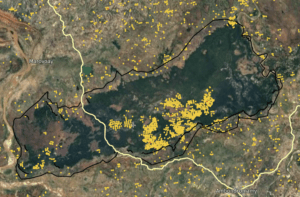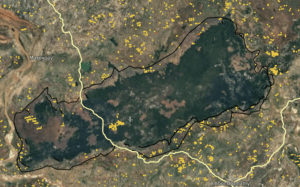A major conservation breakthrough has been achieved in Madagascar’s oldest national park, where forest fires have decreased an astounding 35-fold in just one year. Ankarafantsika National Park, established 97 years ago, is the last stronghold of the Critically Endangered Coquerel’s Sifaka and serves as a crucial water tower feeding rivers into Madagascar’s second most important rice-producing region.
For the past decade, the park’s tropical forests have faced severe threats from cattle-rustling gangs who set fires to create pastures and hide their tracks. With deforestation accelerating to 3.8% per year and just under 50% of forests remaining, the 337,000-acre park was on track to be destroyed within the next decade and was declared Critically Endangered by the Madagascar Protected Area Outlook.
In February 2024, Conservation Allies partnered with Hempel Foundation, FAPBM, KfW, and others to explore urgent solutions to save the 337,000 acre park (the same size as Grand Bahama Island). The major outcome of the two-day meeting was a collective commitment to zero deforestation, significantly stepping up funding for mixed brigade park protection and law enforcement patrols to stop illegal activities by the 100th anniversary of the park in 2027. The impact has been dramatic—forest fires decreased from 1,284 in 2023 to just 36 fires during the same period in 2024.


Acting on this commitment, Conservation Allies tripled support to our Partners (Fosa Association and Madagascar National Parks) specifically to increase Ranger patrols during the peak dry season. We also supported a new “Control Center” for the park to track and coordinate patrols responding to daily satellite reports on fires and forest losses. Furthermore, we offered compensation in the form of essential food supplies to communities around the park if they lit no fires.
This remarkable success in Madagascar headlines a year of significant conservation achievements worldwide. In Colombia, two major new protected areas were established: the Loros Andinos Regional Natural Park, which protects the recovering Yellow-eared Parrot population, and Las Tangaras Regional Natural Park, safeguarding over 5,700 acres of pristine subtropical rainforest. In Ecuador, the Cambugán Protected Forest expanded by 445 acres, securing vital habitat for endangered species like the Andean bear.
With such positive results and dedicated partnership efforts, there is renewed hope that Ankarafantsika National Park can not only survive but thrive, serving as an inspiring example of successful conservation through collaborative, community-driven environmental protection.


